IVF Results 2022
Results for Aagaard Clinic 2022
The results obtained by the clinic are highly satisfactory and in the top end from an international point of view. Since it is our aim to ensure that the pregnancies achieved result in the birth of one child at a time, considering this is the best approach for the mother as well as the child, in our fresh treatments we transferred only 1,02 eggs on average in 2022. As result of this, 98% of the pregnancies involved a single embryo. In more than 99% of our procedures, we culture the embryo to the blastocyst stage which contributes to the high pregnancy rates for single egg transfers.
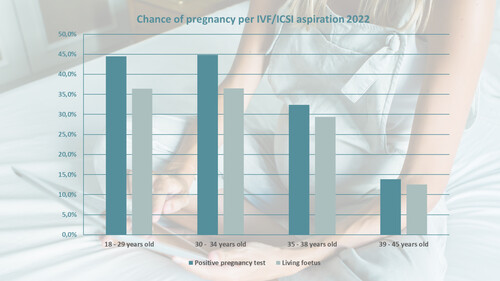
The table above shows the pregnancy probability per egg retrieval for IVF/ICSI treatment. This table includes all IVF and ICSI treatments, ie. also treatments where the egg transfer is cancelled due to a lack of blastocysts on day five or six.
The dark green column in the table shows the chance of a positive pregnancy test for an IVF or ICSI treatment commenced according to a blood sample measured about ten days following the transfer.
The light green column in the table shows the chance of identifying a live embryo (heart reaction) at a scan about five weeks after a single fertilized egg has been transferred to the uterus.
The reason why these columns are not identical is that some pregnancies are termed biochemical pregnancies, ie. the development of the embryo has stopped. The risk of a pregnancy being merely biochemical increases with age and is also a question of biology; this is the single most reason why becoming pregnant becomes increasingly difficult with age.
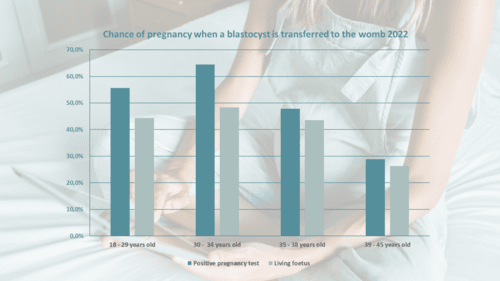
The table above shows the likelihood of a pregnancy when fertilized eggs have been transferred to the uterus.
The dark green column in the table shows the chance of a positive pregnancy test when a single fertilized egg has been transferred to the uterus under an IVF or ICSI treatment commenced according to a blood sample measured about ten days following the transfer.
The light green column in the table shows the chance of identifying a live embryo at a scan about five weeks after a single fertilized egg has been transferred to the uterus.
As discussed above, the two columns are not identical since some pregnancies are biochemical, which means that the development of the embryo stops.
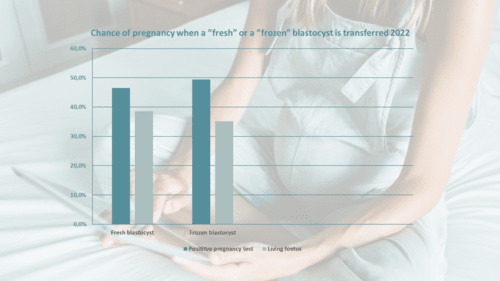
The table above shows our results (average for all ages) for IVF and ICSI treatments with frozen/thawed blastocysts (fertilized eggs) compared with treatments involving fresh eggs.
As can be seen from the table, the chance of the treatment resulting in a pregnancy is the same for “frozen” and “fresh” eggs. (Fresh eggs = Eggs that have not been frozen).
Where a treatment produce several good blasocysts, a single “fresh” fertilized eggs is transferred. Any other good blastocysts are frozen (vitrified) and stored for later use. We also perform an increasing number of treatments according to a freeze-all approach; ie. we freeze all suitable eggs (no fresh transfer).
The dark green column in the table shows the chance of a positive pregnancy test when a freeze procedure is commenced, based on a measurement about ten days following the transfer.
The light green column in the table shows the chance of identifying a live embryo at a scan about five weeks after a single fertilized egg has been transferred to the uterus.
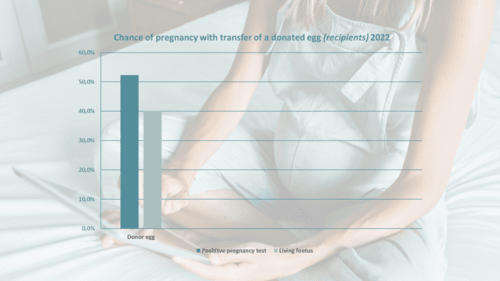
The table above shows our egg donation results (average for all ages). According to our strategy, for our egg donation treatment we freeze (vitrify) blastocysts and later transfer these to the uterus following thawing. This strategy is a more patient-friendly approach since planning a “freeze” cycle is easier than planning a “fresh” cycle. As can be seen from one of the earlier tables, the pregnancy chance does not differ for a pregnancy involving transfer of a “freeze” egg compared with the transfer of a “fresh” egg.
The dark green column in the table shows the chance of a positive pregnancy test when a freeze procedure is commenced, based on a measurement about ten days following the transfer.
The light green column in the table shows the chance of identifying a live embryo at a scan about five weeks after a single fertilized egg has been transferred to the uterus.
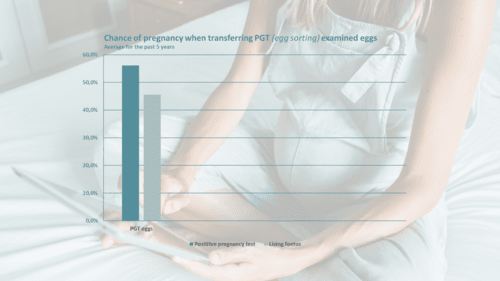
The table above shows our results for PGT-M/PGT-SR/PGT-A treatments (average all ages). Blastocysts are transferred during a freeze cycle since blastocysts are always frozen (vitrified) in connection with egg sorting. A blastocyst is transferred when a PGT-M/PGT-SR/PGT-A analysis has identified normal chromosomes.
The dark green column in the table shows the chance of a positive pregnancy test when a freeze procedure is commenced, based on a measurement about ten days following the transfer.
The light green column in the table shows the chance of identifying a live embryo at a scan about five weeks after a single fertilized egg has been transferred to the uterus.
